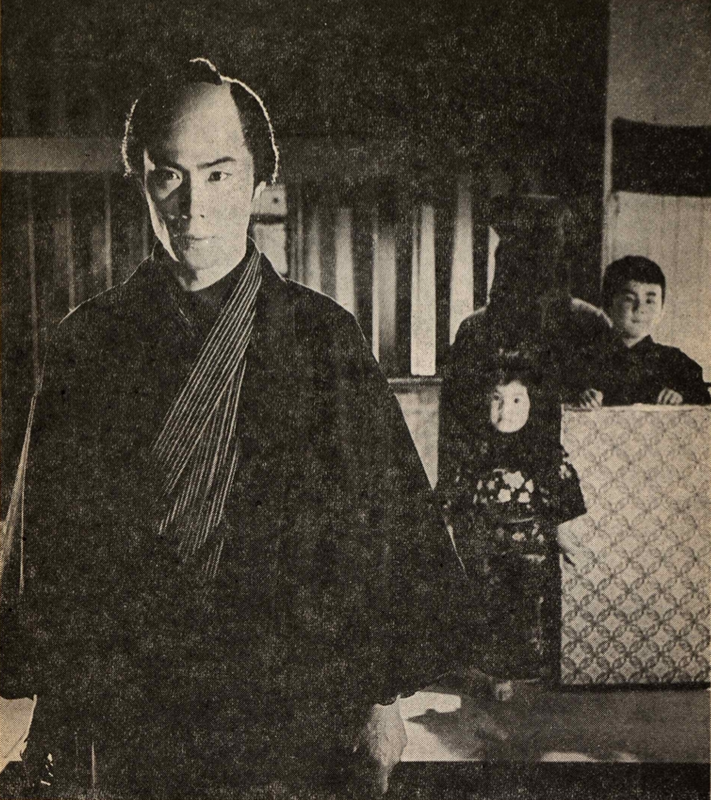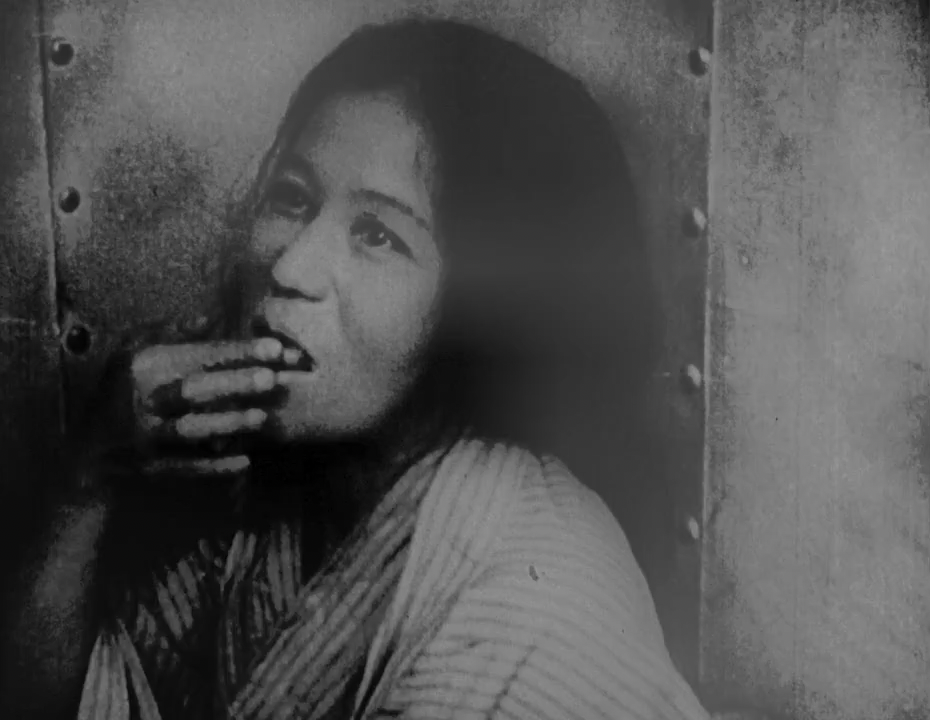“We come to life, we die… It's a perpetual renewal. How boring.”剣 (小説) [Ken / The Sword] (Kenji Misumi, 1964)
Dec
6
rice

Young people eating. An older woman in kimono scoops rice from an electric rice cooker. When read from right to left, this scene – as are numerous others in Chikashi Makiura's photographed 剣 (小説) – are split into tradition and modernity. DP: Chikashi Makiura.
– Mibu
Japan
“I don't know what to do with her Highness. Say right and she'll go left, say left and she'll go right. And though she is a girl, she has never shown me a tear.”隠し砦の三悪人 [Kakushi-toride no san-akunin / The Hidden Fortress] (Akira Kurosawa, 1958)
Nov
25
White Ribbon Day

General Makabe (Toshirō Mifune) facing us with Princess Yuki (Misa Uehara) seemingly standing high above him on the fortress' wall, facing away. DP: Kazuo Yamazaki.
Someone protects a woman on White Ribbon Day
Leave it to popular media to create a fashion for helplessness. In the 110 years that have passed since William Randolph Hearst's titular heroine fought her way to #emancipation in The Perils of Pauline (1914), “the damsel in distress” is still very much the go-to trope for movie writers. Sadly, instead of debunking the belief that women need to be protected by men from men, it's now embraced by third wave feminism. Just yesterday – November 25, 2023 – I saw a call to arms from a leftwing feminist group to “protect girls” from the primal evil that is manhood. Oh how we did better once.
– old lady-in-waiting
In Kurosawa's 隠し砦の三悪人, a couple of greedy peasants escort a man and woman across enemy lines after the man has promised them a share of the gold they're carrying. Unknowingly, the fools not only protect their bounty, but a general and princess trying to escape an enemy clan so they can rebuild their kingdom. And also unbeknownst to the tricksters, Makabe and Yuki are not as helpless as they may seem.
儀式 [Gishiki / The Ceremony] (Nagisa Ōshima, 1971)
Nov
11
World Origami Day

A man kneeled in front of a Shintō altar. Ceremonial origami, known as origata or girei origami can be seen hanging from the altar. This is 幣帛 [heihaku], an offering made of cloth or paper. DP: Tōichirō Narushima.
Goshogaoka [御所ケ丘] (Sharon Lockhart, 1998)
Nov
6
Play Basketball Day

Girls from the Moriya City Goshogaoka junior high school girl basketball team practising their blocking technique. Cibachrome print © Sharon Lockhart, 1997 (via).
Within the boundaries of Sharon Lockhart's static camera, girls from Goshogaoka junior high school practice basketball. In six uninterrupted 10 minute scenes, we see them warm up and train several typical moves, shots, and blocks. With the camera set in one position, some of the action happens off-screen, resulting in unrehearsed synchronised choreography.
瘋癲老人日記 [Fūten rōjin nikki / Diary of a Mad Old Man] (Keigo Kimura, 1962)
Oct
29
World Stroke Day

Utsugi (Sō Yamamura) lusting after his daughter-in-law Sachiko's (Ayako Wakao) feet while she takes a shower. DP: Nobuo Munekawa.
みな殺しの霊歌 [Minagoroshi no reika / I, the Executioner] (Tai Katō, 1968)
Oct
26

A claustrophobically framed black-and-white shot of a man (Makoto Satō) handling chopsticks close to his face. DP: Keiji Maruyama.
心中天網島 [Shinjū: Ten no Amijima / Double Suicide] (Masahiro Shinoda, 1969)
Oct
10
International Stage Management Day

Jihei (Kichiemon Nakamura ) and his children with a stagehand visible between them. DP: Tōichirō Narushima.
心中天網島 is based on a 1721 文楽 [#bunraku] puppet theatre play]. As traditional in this style of theatre, the puppeteers are in full view of the audience wearing all-black cloaks. 心中天網島 does the same, but substitutes the puppets with flesh and blood actors.
The puppeteers are 黒衣 [kuroko, litt. “black clad”, though there are colour variations depending on the scene's requirements], guiding the performers towards their destiny.
鉄輪 [Kanawa / The Iron Crown] (Kaneto Shindō, 1972)
Sep
20
fried eggs

Meg Flower as the young woman eats a fried egg straight from a spatula. She's naked. DP: Kiyomi Kuroda.
狂つた一頁 [Kurutta ippēji / A Page of Madness] (Teinosuke Kinugasa, 1926)
Sep
12

The servant's wife (Yoshie Nakagawa) eating. She looks up at someone offscreen, and smiles. DP: Kōhei Sugiyama.
0課の女 赤い手錠 [Zeroka no onna: Akai wappa / Zero Woman: Red Handcuffs] (Yukio Noda, 1974)
Sep
12
National Police Woman Day

Rei (Miki Sugimoto) wielding the red chain of her handcuffs. DP: Yoshio Nakajima.
Rei (Miki Sugimoto) is a member of Division Zero, a top secret division of #Tokyo's police department. Hired to investigate a high-profile #kidnapping, she infiltrates the gang and kills them off with her signature blood-red handcuffs.
0課の女 赤い手錠 is the first of no less than 9 instalments. Based on Tōru Shinohara's #manga 0課の女 [Zero-ka no Onna] who may be better known for his さそり [Sasori / Scorpion], which in its turn was adapted into the popular Female Prisoner Scorpion series of WiP films.